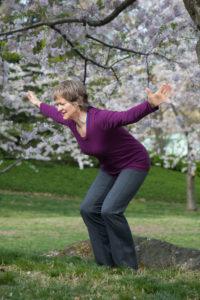 The teams of muscles that support and move your hips are awesome. Even if you’re not an anatomy geek, they are worth getting to know. You have the flexors in the front (with the iliopsoas as the team leader) which bring your leg forward to take a step. Their counterpart is the extensors in the back—gluteus maximus and hamstrings—the push-off muscles for running. We also have teams that rotate the hip joint external rotators (piriformis being the midget but strong team leader here) and the internal rotators, which I’ll talk about below. Another team is the adductors on the inner thighs, a group of five that stabilize the inner thighs, pulling toward the midline.
The teams of muscles that support and move your hips are awesome. Even if you’re not an anatomy geek, they are worth getting to know. You have the flexors in the front (with the iliopsoas as the team leader) which bring your leg forward to take a step. Their counterpart is the extensors in the back—gluteus maximus and hamstrings—the push-off muscles for running. We also have teams that rotate the hip joint external rotators (piriformis being the midget but strong team leader here) and the internal rotators, which I’ll talk about below. Another team is the adductors on the inner thighs, a group of five that stabilize the inner thighs, pulling toward the midline.My favorite group is the abductor-medial rotators, a team of three multitaskers on the outer hips. This group does both abduction (pulling the leg to the side) and medial rotation (turning the leg in toward the midline). Its role for stability is often ignored. Yoga students usually want to “open the hips” and I can understand that, but it’s easy to get fixated on flexibility and ignore our need for strength and stability. In that sense, we can do well to consider practicing some techniques from fitness trainers, and physical therapists.Here are the three muscles: gluteus medius, gluteus minimus, and tensor fascia lata.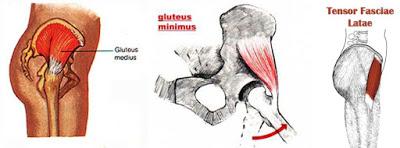 Because of their attachment on the bones above and below, these muscles have a variety of actions, depending on what part of the body is stable. If you put all your weight on one leg, the abductors will move the other leg to the side, and potentially also rotate it a bit. They’ll also be stabilizing your standing leg! Because the gluteus medius has such a wide attachment on the pelvic crest, it can either rotate the thigh externally or internally, as well as abduct it—the multitasker.But if you have your weight on both feet, as in Tadasana or Uttanasana or Utkatasana, the abductors isometrically pull the upper thighs apart without affecting the lower legs, which adds to your stability and prevents compression in the hip joints and the sacro-iliac joint. I think it’s particularly good action in Utkatasana, the pose shown above.You might say: I don’t want to strengthen my outer hips because they’re often achy and tired! Often when the outer hips are achy, it’s because the muscles are reacting to something we’re doing or not doing on a daily basis that causes all the teams to operate in a disorganized way. Perhaps we stand on one leg without realizing it, or we have some other slight imbalance or asymmetry that’s under the radar of ordinary awareness. Gradually over time, some muscles get a lot of stimulus and others not so much. This can be reinforced in our yoga practice or athletic activity like running, once the habits are established.Here are some examples of good additions to your daily practice that highlight these abductor-rotator muscles, both for strength and stretch. First you can isolate them, and then focus on how they play a part in your favorite asanas. Practice these on both sides, of course.1. Side Leg Lift from All Fours: From hands and knees position, lift one leg to the side, at first with the knee bent, and then straighten the leg to the side, as in a slow karate kick with the heel raised slightly. This works the abductor-medial rotator team. Do 10 slow kicks on each side, and increase the number as you get stronger.
Because of their attachment on the bones above and below, these muscles have a variety of actions, depending on what part of the body is stable. If you put all your weight on one leg, the abductors will move the other leg to the side, and potentially also rotate it a bit. They’ll also be stabilizing your standing leg! Because the gluteus medius has such a wide attachment on the pelvic crest, it can either rotate the thigh externally or internally, as well as abduct it—the multitasker.But if you have your weight on both feet, as in Tadasana or Uttanasana or Utkatasana, the abductors isometrically pull the upper thighs apart without affecting the lower legs, which adds to your stability and prevents compression in the hip joints and the sacro-iliac joint. I think it’s particularly good action in Utkatasana, the pose shown above.You might say: I don’t want to strengthen my outer hips because they’re often achy and tired! Often when the outer hips are achy, it’s because the muscles are reacting to something we’re doing or not doing on a daily basis that causes all the teams to operate in a disorganized way. Perhaps we stand on one leg without realizing it, or we have some other slight imbalance or asymmetry that’s under the radar of ordinary awareness. Gradually over time, some muscles get a lot of stimulus and others not so much. This can be reinforced in our yoga practice or athletic activity like running, once the habits are established.Here are some examples of good additions to your daily practice that highlight these abductor-rotator muscles, both for strength and stretch. First you can isolate them, and then focus on how they play a part in your favorite asanas. Practice these on both sides, of course.1. Side Leg Lift from All Fours: From hands and knees position, lift one leg to the side, at first with the knee bent, and then straighten the leg to the side, as in a slow karate kick with the heel raised slightly. This works the abductor-medial rotator team. Do 10 slow kicks on each side, and increase the number as you get stronger.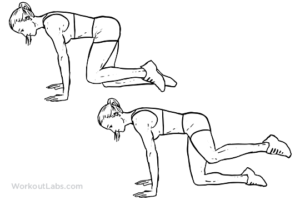 2. Side Plank Pose (Vasishtasana): In this pose, side body strength is emphasized, and the abductor team lifts up the hips. It’s a really good core strengthener. There are many good variations of this pose, and here is one. Hold it for as long as you can, with your supporting shoulder pulled firmly back.
2. Side Plank Pose (Vasishtasana): In this pose, side body strength is emphasized, and the abductor team lifts up the hips. It’s a really good core strengthener. There are many good variations of this pose, and here is one. Hold it for as long as you can, with your supporting shoulder pulled firmly back.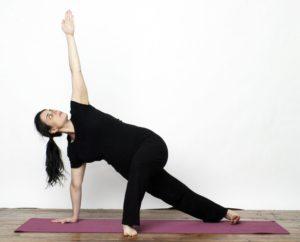 3. Outer Hip and Thigh Stretch: A variation of Supta Padangusthasana, this crosses one leg over the midline, highlighting the outer hip and thigh. Keep your leg muscles strongly contracting as you hold the pose.
3. Outer Hip and Thigh Stretch: A variation of Supta Padangusthasana, this crosses one leg over the midline, highlighting the outer hip and thigh. Keep your leg muscles strongly contracting as you hold the pose.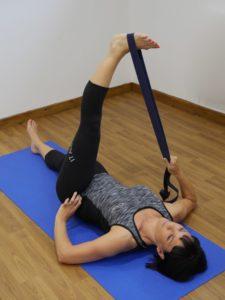 4. Bent Knee Outer Hip Stretch: Be sure to keep the shoulders and pelvis flat on the floor, and adjust your distance from the wall as needed.
4. Bent Knee Outer Hip Stretch: Be sure to keep the shoulders and pelvis flat on the floor, and adjust your distance from the wall as needed.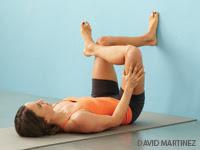 I hope this has piqued your interest in your hip muscles! You can appreciate the contribution of these multitaskers in all standing poses, but especially in any balance pose, such as Vrksasana (Tree Pose), Trikonasana (Triangle Pose), and Ardha Chandrasana (Half-Moon Pose).
I hope this has piqued your interest in your hip muscles! You can appreciate the contribution of these multitaskers in all standing poses, but especially in any balance pose, such as Vrksasana (Tree Pose), Trikonasana (Triangle Pose), and Ardha Chandrasana (Half-Moon Pose).
For more on the hip muscles, see my book Anatomy and Yoga: A Guide for Teachers and Students, available online and in bookstores. For information on my online weekly classes, see here.This article originally appeared on ellensaltonstall.com. Ellen Saltonstall (ERYT-500, C-IAYT, YACEP) is an alignment-based yoga instructor and body therapist based in New York City with over 40 years of experience. Her background includes modern dance, a massage therapy practice, Iyengar Yoga and Anusara Yoga. She was certified in Anusara Yoga in 2001, then became a Subject Matter Specialist in anatomy and therapeutics. In addition to yoga, she teaches Bodymind Ballwork, a method of bodywork using rubber balls to facilitate tension release. Her published books include Yoga for Arthritis (2008), Yoga for Osteoporosis (2010), Anatomy and Yoga (2016), and The Bodymind Ballwork Method (2018). She offers yoga therapy webinars through YogaOnlineU.com, and she teaches nationally and internationally with a specialty in anatomy and therapeutics. She is known for her clarity, depth of knowledge, and enthusiasm in encouraging students of all levels to find freedom and joy through yoga. More information here.
Ellen Saltonstall (ERYT-500, C-IAYT, YACEP) is an alignment-based yoga instructor and body therapist based in New York City with over 40 years of experience. Her background includes modern dance, a massage therapy practice, Iyengar Yoga and Anusara Yoga. She was certified in Anusara Yoga in 2001, then became a Subject Matter Specialist in anatomy and therapeutics. In addition to yoga, she teaches Bodymind Ballwork, a method of bodywork using rubber balls to facilitate tension release. Her published books include Yoga for Arthritis (2008), Yoga for Osteoporosis (2010), Anatomy and Yoga (2016), and The Bodymind Ballwork Method (2018). She offers yoga therapy webinars through YogaOnlineU.com, and she teaches nationally and internationally with a specialty in anatomy and therapeutics. She is known for her clarity, depth of knowledge, and enthusiasm in encouraging students of all levels to find freedom and joy through yoga. More information here.

